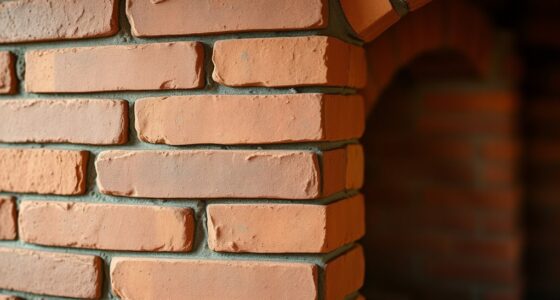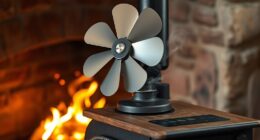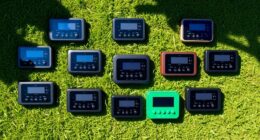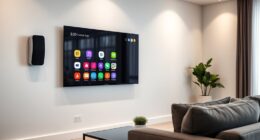To correctly use your moisture meter, first guarantee it’s properly calibrated using built-in settings or reference standards. Insert the probes into the material at the recommended depth, then observe the display—usually in percentage or other units—comparing it to typical moisture levels for that material. Consider environmental factors like temperature and humidity that can affect results. Regularly verify and maintain your device, and you’ll gain reliable, accurate measurements—keep exploring to learn more about precise technique.
Key Takeaways
- Insert probes properly at the recommended depth for accurate readings.
- Observe and interpret display units, such as percentages, according to material standards.
- Ensure the meter is calibrated correctly before measuring for reliable results.
- Consider environmental factors like temperature and humidity, using automatic temperature compensation if available.
- Use the hold function to record readings in hard-to-reach or fluctuating measurement areas.

Understanding how to read a moisture meter is essential for accurately measuring the moisture content in various materials. Whether you’re working with wood, drywall, soil, or other substances, knowing how to interpret the readings ensures your project’s success. To do this effectively, you need to understand the importance of proper calibration techniques. Calibration is the process of setting your moisture meter to guarantee its readings are accurate. Many meters come with calibration settings or reference standards; you should regularly verify these against known moisture levels to prevent errors. For example, if you’re measuring wood, use a moisture meter with a built-in calibration feature or calibrate it manually with a standard sample. This step is crucial because even minor calibration errors can lead to inaccurate readings, affecting your decisions on drying, sealing, or treating materials.
Proper calibration ensures accurate moisture readings for reliable project results.
Once your meter is calibrated correctly, you can proceed to take measurements. Insert the probes into the material at the appropriate depth, following the manufacturer’s instructions for your specific model. When reading the display, pay attention to the units used, whether percentage or other scales, and compare them to recommended moisture levels for your material type. Keep in mind that environmental conditions, such as temperature and humidity, can influence readings. Some meters have automatic temperature compensation, but if yours doesn’t, you should adjust your readings accordingly. Additionally, understanding material-specific moisture levels is essential for making informed decisions and ensuring the integrity of your work.
Troubleshooting tips are vital for maintaining accuracy and ensuring your measurements are reliable. If your readings seem inconsistent or suddenly fluctuate, first check the calibration. Recalibrate if necessary. Dirty or corroded probes can also cause erratic results, so clean them regularly with a soft cloth or mild cleaning solution. If the readings are still off, verify that you’re using the correct setting for your material. Different materials require different measurement modes or settings, so always double-check before testing. Additionally, if your moisture meter has a hold function, use it to lock in readings for easier recording, especially in hard-to-reach spots.
Finally, always compare your readings with known standards or reference materials when possible. This practice helps verify that your meter functions correctly over time. Keep a log of calibration dates and any troubleshooting steps you perform to track the meter’s accuracy. Regular maintenance and proper calibration techniques will extend the life of your moisture meter and ensure your measurements remain precise. By mastering these fundamentals, you’ll confidently interpret your readings and make informed decisions for your projects.
Frequently Asked Questions
Can Moisture Meters Be Used on All Materials?
Moisture meters can’t be used on all materials because of material compatibility issues. Some meters work well with wood or drywall but may not give accurate readings on metals, plastics, or dense materials. You need to consider how different materials absorb moisture and whether your device’s sensors are compatible. Always check your moisture meter’s specifications to ensure it’s suitable for your specific material, guaranteeing accurate moisture readings.
How Often Should I Calibrate My Moisture Meter?
Calibrate your moisture meter regularly to maintain precise performance. Follow a consistent calibration schedule—ideally, once a month or before critical measurements—to guarantee accuracy assurance. Frequent calibration helps you catch drifting readings and keeps your device dependable. If you notice inconsistent results, calibrate immediately. Remember, diligent calibration keeps your measurements trustworthy, saving you time, trouble, and unnecessary errors in your moisture monitoring tasks.
What Do I Do if Readings Vary Between Measurements?
If your measurements vary between readings, first check your measurement consistency by ensuring you’re applying the meter correctly each time. Then, verify your calibration frequency; if it’s been a while since calibration, recalibrate your device. Variations can also indicate the need for calibration or a malfunction. Always clean the electrodes and avoid taking measurements in fluctuating environmental conditions to maintain accuracy and reliable results.
Are Digital Moisture Meters More Accurate Than Analog Ones?
Digital moisture meters are more accurate than analog ones because digital accuracy offers precise readings, reduces human error, and provides clearer results. Analog reliability, on the other hand, depends on consistent calibration and craftsmanship, which can vary. You benefit most by choosing digital for quick, exact measurements and trusting analog tools when they’re well-maintained. Both types serve their purpose, but digital meters generally deliver superior accuracy in your moisture detection tasks.
How Does Temperature Affect Moisture Meter Readings?
Temperature notably impacts your moisture meter readings because higher temperatures can cause readings to appear lower, while cooler temps might make them seem higher. This is due to humidity impact and how moisture levels react to temperature changes. Always perform a temperature correction, especially if your environment varies. By adjusting your readings for temperature, you ensure more accurate moisture content detection, helping you make better decisions about your materials or wood.
Conclusion
Now that you’ve mastered reading your moisture meter, you’ll confidently detect moisture levels like a seasoned prospector in the Old West. Remember, proper interpretation guarantees your project stays on track, whether you’re woodworking or checking drywall. Don’t forget to calibrate it regularly—no need for a crystal ball, just good habits! With your trusty moisture meter, you’ll keep your surfaces dry and your craftsmanship legendary. Happy measuring, and may your projects always stay moisture-free!









